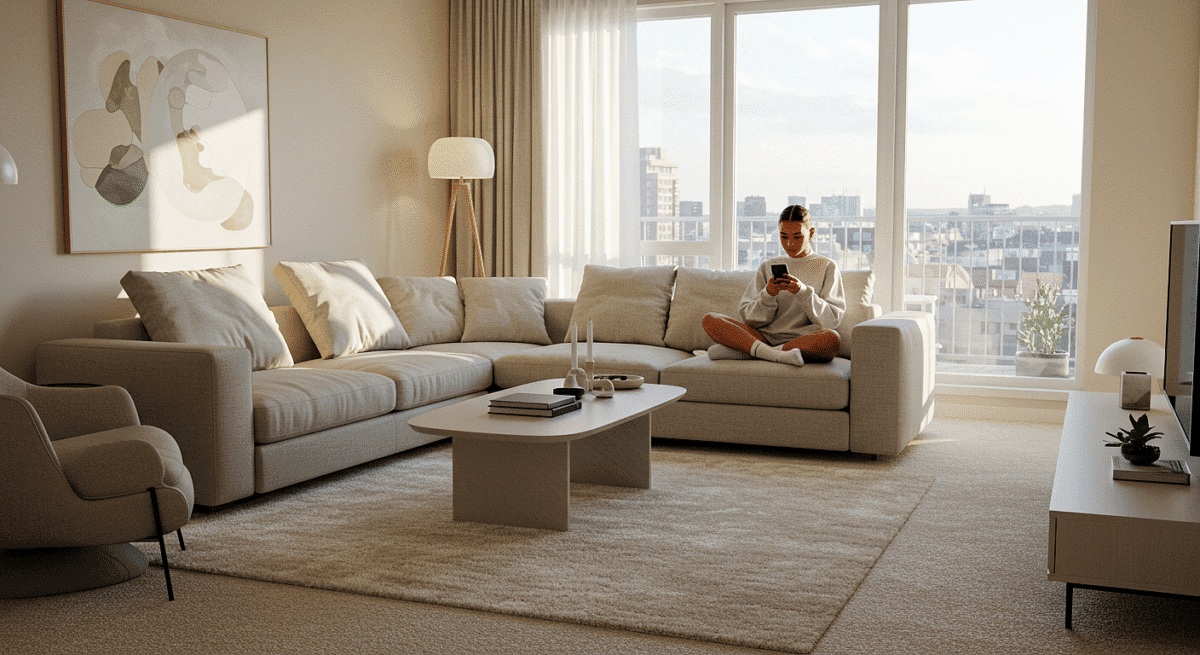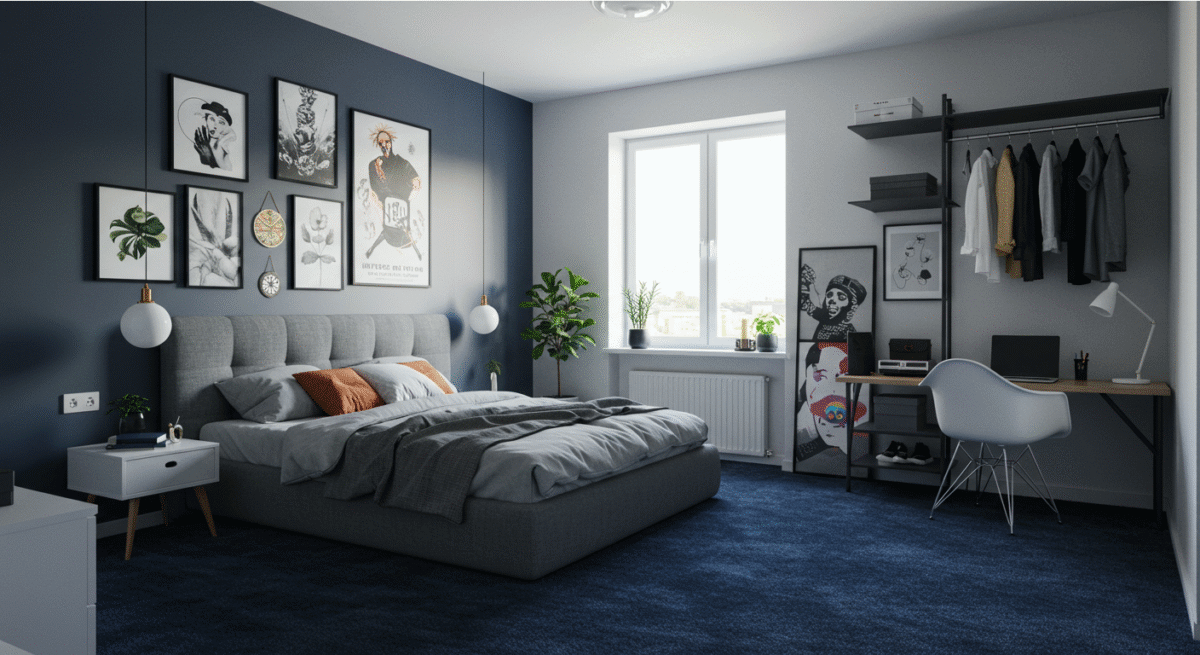Table of Contents
Ever wondered why some carpets feel luxurious underfoot whilst others seem to flatten after just a few months? The secret lies in what’s hidden beneath—your carpet underlay can increase your flooring’s lifespan by up to 50%.
Your carpet deserves the perfect foundation. Yet many homeowners focus solely on choosing beautiful carpet colours and textures, completely overlooking this crucial layer that sits silently beneath. Quality underlay doesn’t just protect your investment—it transforms your entire flooring experience. The best carpet underlay delivers thermal insulation that cuts energy bills, creates that gorgeous soft feeling when you walk across the room, and can make your carpet 2.5 times quieter. Perfect if you’ve got little ones running about!
You’ll find that exploring different carpet underlay types opens up possibilities to enhance comfort in ways you never imagined. Quality options smooth out those annoying subfloor imperfections and absorb the impact of daily foot traffic. Most importantly, the right underlay prevents your carpet pile from flattening, keeping your flooring looking fresh and new for years to come. [-4]
But here’s where it gets tricky—with so many different materials and specifications available, choosing what underlay suits your specific needs can feel overwhelming.
Don’t worry though. This straightforward guide will walk you through everything you need to know about selecting the perfect underlay for your home. Your carpet will not only look better but perform better and last longer too.
What is Carpet Underlay and Why It Matters

Carpet underlay remains the unsung hero of flooring. Most homeowners focus on choosing gorgeous carpet colours and textures, yet this hidden layer plays a crucial role in your carpet’s performance and longevity.
What is carpet underlay?
Carpet underlay is the supportive material layer that sits between your subfloor and carpet. Hidden from view, its effects are evident with every step you take. This cushioning layer comes in various materials, including polyurethane (PU) foam, sponge rubber, felt, crumb rubber, and eco-friendly options. Each material offers unique benefits designed to enhance your flooring experience.
The primary purpose of underlay is creating a stable foundation for your carpet. It acts as a protective barrier that cushions your carpet from below whilst providing numerous functional benefits. Think of it as the backbone of your flooring system—invisible yet fundamentally important for overall performance.
Why underlay is essential for flooring
Without proper underlay, your carpet’s lifespan could be drastically reduced. Studies show that quality underlay can extend your carpet’s life by up to 50%. This makes it not merely an optional extra but an essential investment.
Beyond longevity, underlay delivers several significant advantages:
- Enhanced comfort – Creates a softer, more luxurious feel underfoot by providing additional cushioning
- Improved thermal insulation – Reduces heat loss through flooring, with estimates suggesting a minimum of 10% of a home’s heat is lost through the floor
- Significant noise reduction – Absorbs sound from footsteps and furniture movement, reducing noise transmission between floors
- Better hygiene – Forms a barrier against dust and allergens, making cleaning more effective
- Moisture protection – Prevents dampness rising from the subfloor, especially important in areas like kitchens and bathrooms
Furthermore, a high-quality thermal underlay can help reduce energy bills by up to 15%, making it an economically sound decision over time.
How underlay supports carpet performance
The relationship between underlay and carpet performance is straightforward—underlay functions as a shock absorber, taking the brunt of daily foot traffic and furniture weight. This protective function distributes pressure more evenly across the carpet surface, preventing premature wear patterns and maintaining the carpet’s appearance for longer.
Even lower-cost carpets can perform better with the right underlay beneath them. A good quality underlay can elevate an affordable carpet by providing additional support and resilience. This makes it possible to achieve excellent results within your budget by balancing carpet and underlay quality.
Moreover, underlay helps maintain your carpet’s original appearance by preventing the flattening of carpet fibres. Without this support, carpets tend to show signs of wear much sooner, particularly in high-traffic areas. The cushioning effect minimises indentation from furniture, preserving your carpet’s aesthetic appeal.
For homeowners with underfloor heating, specific low-tog underlays allow efficient heat transfer whilst still providing the essential support your carpet needs. Meanwhile, those seeking sound insulation can select denser options that reduce noise by up to 30%.
What makes carpet underlay so important is that it simultaneously protects your investment whilst enhancing the comfort and functionality of your home.
Benefits of Using the Right Underlay
The right carpet underlay delivers benefits that go way beyond simply cushioning your steps. Choosing the appropriate type from various carpet underlay options can completely change how your flooring feels and performs.
Improved comfort and softness
Have you ever walked across a carpet that felt absolutely divine underfoot? That’s quality underlay working its magic. High-quality options like PU foam underlay contain air pockets that provide exceptional cushioning, making every step across your carpeted floor genuinely comfortable. This cushioning effect absorbs impacts when you walk, reducing strain on joints and muscles. Premium underlays, such as those in the Tredaire range, enhance the elasticity of your flooring, offering a “bounce back” effect that creates a sumptuous walking experience.
Better insulation and energy savings
Here’s where your underlay becomes a real money-saver. Quality underlay functions as an effective thermal barrier, reducing heat loss through your floors by trapping air within its structure. Studies show that approximately 10-11% of a home’s generated warmth escapes through cold sub-floors. Underlays with high tog ratings effectively block cold air whilst preventing warm air from escaping. The Energy Saving Trust estimates that insulating ground floors in UK homes can save an average of £60 to £100 annually, depending on home size and location.
Noise reduction and soundproofing

Want a quieter home? The best carpet underlays act as excellent sound barriers, dampening both impact noises (like footsteps) and airborne sounds (such as voices or music). Acoustic underlay can reduce noise by a minimum of 40 decibels, creating significantly quieter living environments. For wood and laminate floors, appropriate underlay can reduce in-room noise by up to 30%. Every 10-decibel reduction in noise level is roughly perceived as halving the loudness—making proper acoustic underlay essential for multi-story homes or apartments.
Longer carpet lifespan
Without question, extending your carpet’s life represents one of the most valuable benefits. Underlay functions as a shock absorber, reducing the impact of daily foot traffic and furniture weight on carpet fibres. This protection can extend your carpet’s lifespan by up to 50%, preserving its original appearance and structure far longer than installation without underlay. Quality underlay prevents carpets from developing indentations and helps them retain their shape even in high-traffic areas.
Easier cleaning and hygiene
Underlay significantly improves carpet hygiene by creating a stable surface for more effective vacuuming. It acts as a barrier against dust, allergens and pollutants, preventing them from embedding deeply into carpet fibres. Moisture-resistant underlays with damp-proof membranes protect against spills penetrating to the subfloor, giving you more time to clean before permanent staining occurs. This moisture protection prevents issues like mould growth, particularly valuable in areas prone to humidity.
The underlay you choose for your carpet matters considerably—the right selection delivers benefits spanning comfort, efficiency, quietness, longevity and cleanliness throughout your home.
What are the different types of carpet underlay available?
Understanding your carpet underlay options helps you make the right choice for your home. Each type brings unique properties that suit different rooms and requirements.
PU foam underlay
Polyurethane (PU) foam remains the most popular choice amongst UK homeowners. Made from up to 85% recycled materials like mattresses and sofa cushions, it delivers exceptional cushioning underfoot. PU foam provides excellent thermal insulation and sound absorption whilst being lightweight and easy to handle. This type typically lasts between 10-15 years and works particularly well in bedrooms and living rooms due to its softness. For areas with underfloor heating, specific PU foam varieties are available.
Sponge rubber underlay
One of the most traditional options available since the 1950s, sponge rubber underlay creates an extremely springy and comfortable walking experience. Its flexibility surpasses that of PU foam, making it suitable for both domestic and commercial environments. Available in waffled or flat profiles, this luxury type has been among Europe’s best-selling underlays for over 30 years. Sponge rubber underlay works excellently with underfloor heating systems due to its low tog varieties that allow efficient heat transfer.
Felt underlay
Made from 100% recycled textile fibres including jute, wool, and even old clothes, felt underlay provides a firm, dense layer particularly suitable for woven carpets. Despite its traditional nature, felt offers superior thermal insulation, preventing cold air from rising through subfloors. This makes it exceptionally energy-efficient. Felt underlay has seen a resurgence in commercial and domestic settings owing to its hardwearing properties and environmental credentials.
Crumb rubber underlay
Created from recycled car tyres, crumb rubber underlay stands out for its exceptional durability and resilience. It maintains its shape even under heavy pressure, making it ideal for high-traffic areas like stairs, hallways, and commercial spaces. This type offers the unique advantage of 100% recovery under load, preventing carpet indentation from furniture. Its natural moisture resistance makes it suitable for concrete subfloors.
Cork and eco-friendly options
Environmentally conscious homeowners can choose from several green options. Cork underlay provides excellent acoustic properties while being naturally biodegradable. Other eco-friendly alternatives include wool fibre underlay—a 100% natural and renewable option—and AirFlow underlay made from natural wood fibres that is completely non-toxic and fully biodegradable.
Combination underlay
Often called felt and rubber carpet underlay, combination types offer “the best of both worlds”. These feature recycled crumb rubber on the bottom (containing at least one car tyre per square metre) and 100% recycled fibres on top. This construction provides maximum comfort while withstanding high foot traffic, making it perfect for busy areas. Combination underlays typically deliver superior sound reduction properties, with some featuring up to 80% wool content for enhanced luxury.
How to Choose the Best Carpet Underlay for Your Home
Ready to find your perfect match? Selecting the right underlay involves several key considerations that directly impact how your flooring performs, feels and lasts. Follow these guidelines to choose the best carpet underlay for your specific needs.
Match underlay to carpet type

Your carpet and underlay need to work together seamlessly. Different carpet constructions require specific underlay support:
- Loop pile (Berber) carpets: Need medium-firm underlays that provide solid support without compromising those unique loops. Soft or excessively thick underlays may cause over-compression and damage these carpets.
- Twist carpets: Love softer underlays that enhance their natural comfort. Avoid anything too dense or hard, which could reduce the carpet’s lovely plushness.
- Velvet pile carpets: Work beautifully with soft, plush underlays that enhance their luxurious feel whilst keeping things warm.
- Saxony carpets: Benefit from good cushioning underlays that complement their softness—steer clear of harder varieties that detract from their plush nature.
- Woven carpets: Pair well with firmer underlays that can properly support their weight and structure.
Consider the room’s purpose
Each room in your home has unique requirements that should guide your underlay choice:
Bedrooms and living rooms—areas with moderate foot traffic—deserve thicker, luxury-feeling underlays like PU foam or wool felt for optimal comfort. Dining rooms benefit from denser underlays that resist furniture indentation.
High-traffic areas demand underlays that withstand intensive use. For these spaces, durability should take precedence over extreme softness.
Think about subfloor material
Your existing floor surface plays a crucial role in determining appropriate underlay:
Concrete floors need underlays offering thermal insulation like sponge rubber or felt. These prevent cold transfer and reduce dampness.
Wooden subfloors accommodate most underlay types but benefit from options that prevent slippage and provide sound insulation.
Underlay for stairs and high-traffic areas
Stairs present unique challenges requiring specific underlay considerations:
Thickness matters significantly—the optimal underlay thickness for stairs is 9-10mm maximum. Anything thicker becomes difficult to fit around steps and potentially creates safety hazards.
Density becomes critical for stairs and hallways. High-density underlays (approximately 100kg/m³) deliver better durability and compression recovery, essential for these heavily used areas.
Remember that crumb rubber and combination underlays excel in these demanding locations due to their superior resilience and ability to maintain shape under constant pressure.
Understanding Tog Ratings and Thickness
Getting your head around carpet underlay specifications might seem daunting, but these two key measurements—tog rating and thickness—make all the difference to how your floors perform and feel.
What is a tog rating?
Think of tog rating as your underlay’s thermal resistance or insulation power. Just like duvets, carpet underlays have tog levels that tell you exactly how well they retain heat. The scale typically ranges from 1.0 to 4.0—higher values mean better insulation. Essentially, tog values show you how effectively your underlay prevents heat from escaping through the floor.
Ideal tog ratings for underfloor heating
Got underfloor heating? Then choosing the right tog ratings becomes absolutely crucial. The combined tog value of both your carpet and underlay should never exceed 2.5 for the system to work efficiently. Homes with heat pumps need even lower combined ratings, ideally under 1.5. That’s why underlays designed specifically for underfloor heating typically come in thinner varieties (6-8mm) with lower tog ratings. Here are some popular examples:
- Technics 5 (5.0mm) – 0.56 tog
- Technics 6 (6.0mm) – 0.66 tog
- Willow Green waffle rubber (8.4mm) – 1.1 tog
How thickness affects comfort and durability
Thickness plays a huge role in both comfort and insulation. Thicker carpet underlays (10-12mm) generally give you better cushioning underfoot whilst offering superior insulation against cold and sound. These options create that luxurious feel you want in living spaces.
Density matters just as much for durability—experts recommend density above 100 kg/m³ to ensure your underlay actually outlasts your carpet. Getting this balance between thickness and density right becomes particularly important in high-traffic areas.
Recommended thickness by carpet type
Different rooms in your home need specific underlay thicknesses:
For living rooms and bedrooms, 11-12mm thick options deliver premium comfort and warmth with higher tog ratings around 3.5. But for stairs and hallways, you’ll want thinner options (9-10mm) that provide better stability and safety. Anything thicker than 10mm on stairs can create trip hazards and lead to uneven wear patterns.

The key is balancing tog rating and thickness according to what each room actually needs—that’s how you get optimal performance from your chosen carpet underlay types.
Conclusion
Your carpet deserves the perfect foundation, and now you know exactly how to give it one.
Quality underlay creates that luxurious feeling underfoot whilst cutting your energy bills and making your home beautifully quiet. Most importantly, it keeps your carpet looking fresh and new for years to come—preventing that dreaded flattening that ruins the appearance of even the most expensive carpets.
Remember to match your underlay to your carpet type and room purpose. PU foam works beautifully for bedrooms and living spaces, whilst crumb rubber excels where you need serious durability. Don’t forget about your subfloor material—concrete floors particularly benefit from thermal insulation properties.
Pay attention to tog ratings if you have underfloor heating, and choose your thickness wisely. Thicker options for comfort in living spaces, thinner varieties for safety on stairs.
The right carpet underlay is a smart investment that pays you back through enhanced comfort, better insulation, reduced noise, and extended carpet life.
You’re now armed with everything you need to choose the perfect underlay for your home. Your carpet will thank you for it—and so will your family when they experience that gorgeous, comfortable feeling underfoot every single day.
Key Takeaways
Choosing the right carpet underlay can dramatically improve your flooring’s performance, comfort, and longevity whilst reducing energy costs.
• Quality underlay extends carpet lifespan by up to 50% and reduces energy bills by up to 15% through improved thermal insulation.
• Match underlay type to your needs: PU foam for comfort in bedrooms, crumb rubber for high-traffic areas, and felt for thermal efficiency.
• Consider tog ratings carefully—combined carpet and underlay should not exceed 2.5 tog for underfloor heating systems to work efficiently.
• Thickness matters for safety and performance: use 11-12mm for living spaces but limit stairs to 9-10mm maximum to prevent trip hazards.
• Density above 100kg/m³ ensures your underlay outlasts your carpet, making it a worthwhile long-term investment for any home.
The right underlay choice balances comfort, durability, and energy efficiency whilst protecting your carpet investment for years to come.
FAQs
Q1. What factors should I consider when choosing carpet underlay? Consider the type of carpet, room purpose, subfloor material, and whether you have underfloor heating. Match the underlay to your carpet type, select appropriate thickness and density for high-traffic areas, and ensure proper tog ratings for efficient heat transfer if you have underfloor heating.
Q2. How thick should carpet underlay be? The ideal thickness depends on the room’s purpose. For living rooms and bedrooms, 11-12mm thick options provide premium comfort. For stairs and hallways, use thinner options (9-10mm) for better stability and safety. Avoid underlays thicker than 10mm on stairs to prevent trip hazards.
Q3. What is a tog rating and why is it important? A tog rating measures the thermal resistance of underlay. Higher values (1.0 to 4.0) indicate better insulation. It’s crucial for homes with underfloor heating, where the combined tog value of carpet and underlay should not exceed 2.5 for efficient operation.
Q4. Which type of underlay is best for high-traffic areas? For high-traffic areas like stairs and hallways, choose durable options such as crumb rubber or combination underlays. These materials maintain their shape under constant pressure and offer superior resilience. Look for high-density underlays (around 100kg/m³) for better durability.
Q5. How does underlay affect carpet lifespan and energy efficiency? Quality underlay can extend your carpet’s life by up to 50% by absorbing daily wear and tear. It also improves thermal insulation, potentially reducing energy bills by up to 15%. The right underlay acts as a shock absorber, preventing premature wear patterns and maintaining the carpet’s appearance for longer.